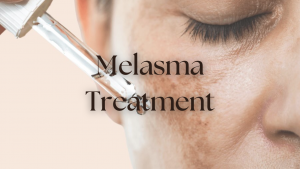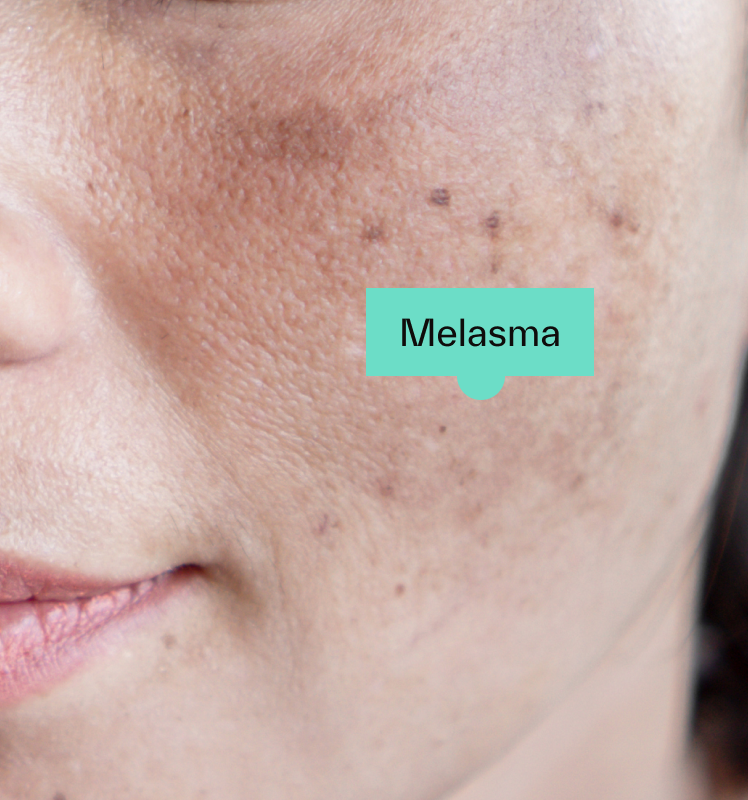Melasma Treatment – Causes, Remedies, and Best Solutions
Melasma is a common skin condition that causes dark patches to appear on the face, particularly on the cheeks, forehead, nose, and upper lip. While it is not harmful, melasma can be frustrating and affect one’s confidence. This condition is more prevalent in women, especially those with darker skin tones, and is often triggered by hormonal changes, sun exposure, and genetics.
If you’re struggling with melasma, the good news is that various treatment options can help reduce pigmentation and prevent it from worsening. From topical creams to professional procedures, finding the right approach depends on your skin type and the severity of the condition. In this guide, we’ll explore the best melasma treatment options, skincare routines, and prevention tips to help you achieve clearer, more even-toned skin.

What is Melasma?
Melasma is a skin condition characterized by dark, discolored patches that typically appear on areas of the face exposed to the sun, such as the cheeks, forehead, nose, and upper lip. It occurs due to an overproduction of melanin, the pigment responsible for skin color. While melasma is not harmful or painful, it can be persistent and difficult to treat, making it a common cosmetic concern for many individuals.
This condition is often triggered by hormonal changes, which is why it is frequently seen in pregnant women, earning it the nickname “the mask of pregnancy.” Hormonal fluctuations caused by birth control pills or hormone therapy can also contribute to its development. Sun exposure is another major factor, as ultraviolet (UV) rays stimulate melanocytes—the cells responsible for melanin production—leading to increased pigmentation. Genetics also play a role, with a higher likelihood of developing melasma if there is a family history of the condition. Additionally, certain medications, including those that increase sensitivity to sunlight, can exacerbate melasma.
Unlike freckles or post-inflammatory hyperpigmentation caused by acne, melasma presents as larger, symmetrical patches that often cover both sides of the face. It does not cause redness, itching, or discomfort, but its chronic nature makes it challenging to manage. Since it can be triggered by multiple factors, effective treatment requires a combination of sun protection, skincare products, and, in some cases, professional dermatological procedures.

Melasma Treatment Option
Melasma can be stubborn, but the good news is that there are many ways to lighten the dark patches and even out your skin tone. Treatments range from simple creams to advanced dermatological procedures, depending on how severe the condition is. Let’s explore the most common options and how they work.
Topical Treatments
Many people start treating melasma with topical creams and serums. These products contain ingredients that help lighten dark patches by reducing melanin production.
One of the most commonly used ingredients is hydroquinone. It works by blocking the pigment-producing cells in the skin, gradually fading the dark areas. However, it should be used with caution, as long-term use or high concentrations may cause skin irritation. It’s best to use it under the guidance of a dermatologist.
Retinoids, like tretinoin, are another effective option. They help speed up skin cell turnover, allowing new, healthier skin to replace pigmented areas. Some treatments also include corticosteroids, which help reduce inflammation and improve results when combined with hydroquinone.
Other skin-lightening agents, such as Vitamin C, kojic acid, and azelaic acid, are great alternatives. Vitamin C is a powerful antioxidant that brightens the skin and reduces dark spots over time. Kojic acid and azelaic acid work by gently exfoliating and slowing down pigment production. These ingredients are often found in serums and creams that can be used as part of a daily skincare routine.
Professional Procedures
If topical treatments don’t give you the results you want, dermatologists offer a range of professional procedures that can help fade melasma more effectively.
Chemical peels are a popular option that involves applying a special solution to the skin, which causes it to peel and reveal fresher, lighter skin underneath. Some of the best chemical peels for melasma contain glycolic acid or trichloroacetic acid (TCA), which help break down excess pigmentation.
Laser therapy is another treatment, but it comes with pros and cons. Lasers target the dark spots with light energy to break up the pigment, but some types of lasers can actually make melasma worse if not done correctly. That’s why it’s important to see an experienced dermatologist if you’re considering this option.
Microneedling is a newer treatment that involves tiny needles creating micro-injuries in the skin, stimulating collagen production and helping to even out pigmentation. Some dermatologists also combine microneedling with topical treatments for better absorption and faster results.
Natural and Home Remedies
For those who prefer natural options, some home remedies may help improve melasma, though results vary from person to person.
Aloe vera is a soothing ingredient known for its skin-healing properties. It may help lighten dark patches over time while keeping the skin hydrated. Turmeric, a natural anti-inflammatory, has also been used for brightening skin, though its effectiveness on melasma is still debated. Apple cider vinegar contains acetic acid, which some believe can help fade pigmentation, but it must be diluted to avoid irritation.
Aside from topical remedies, what you eat and drink also plays a role in skin health. Staying hydrated and eating a diet rich in antioxidants, vitamins, and healthy fats can support your skin’s natural healing process. Foods like berries, green leafy vegetables, nuts, and fish are great for overall skin health.
No matter which treatment you choose, patience and consistency are key. Melasma takes time to fade, and a good skincare routine, combined with sun protection, will help you see the best results. If your melasma isn’t improving, consulting a dermatologist can help you find the most effective solution for your skin type.
Best Skincare Routine for Melasma
A well-planned skincare routine is one of the most effective ways to manage melasma and prevent it from getting worse. Since melasma is often triggered by sun exposure and inflammation, choosing the right products and avoiding harsh ingredients can make a big difference in keeping your skin clear and even-toned.
The Importance of Sunscreen
Sunscreen is the most important step in any melasma skincare routine. Sun exposure is one of the biggest triggers for melasma, as UV rays stimulate melanin production, making dark patches more visible. Even the best treatments won’t work if your skin isn’t protected from the sun.
To effectively shield your skin, choose a broad-spectrum sunscreen with at least SPF 30 to 50. A mineral-based sunscreen with zinc oxide or titanium dioxide is ideal, as these ingredients create a physical barrier that reflects UV rays. Sunscreens with iron oxide also help protect against visible light, which can worsen pigmentation. It’s essential to apply sunscreen every morning, even on cloudy days, and reapply every two hours if you’re outdoors. Wearing a wide-brimmed hat and sunglasses can offer extra protection.
Best Skincare Ingredients for Reducing Pigmentation
In addition to sunscreen, using skincare products with brightening and exfoliating ingredients can help fade melasma over time. Some of the most effective ingredients include:
- Vitamin C – A powerful antioxidant that helps brighten the skin and reduce pigmentation by inhibiting melanin production.
- Niacinamide – Also known as Vitamin B3, it helps even out skin tone, reduces inflammation, and strengthens the skin barrier.
- Azelaic Acid – A gentle exfoliant that helps fade dark spots and prevent new ones from forming.
- Kojic Acid – Derived from fungi, this ingredient slows down melanin production and works well for hyperpigmentation.
- Tranexamic Acid – An emerging ingredient that has been shown to effectively reduce melasma by blocking pigmentation pathways in the skin.
- Retinoids – These Vitamin A derivatives speed up cell turnover, allowing new, fresh skin to replace pigmented areas.
Using these ingredients in a gentle, hydrating routine can help improve skin tone and prevent melasma from worsening. However, it’s important to introduce them gradually and always follow with sunscreen, as some of these ingredients can make the skin more sensitive to the sun.
What to Avoid in Your Skincare Routine
While the right products can help fade melasma, using the wrong ones can make it worse. Avoiding certain skincare habits and ingredients is just as important as using effective treatments.
- Harsh exfoliants and scrubs – Over-exfoliating can irritate the skin, causing inflammation that worsens pigmentation. Stick to gentle exfoliation a few times a week instead.
- Alcohol-based products – These can dry out the skin and disrupt the skin barrier, leading to increased sensitivity.
- Fragrances and essential oils – Some fragrances and natural oils can trigger irritation and make melasma worse, especially for sensitive skin types.
- Hydroquinone overuse – While hydroquinone is an effective skin-lightening agent, using it for too long without breaks can cause side effects like ochronosis, which leads to a bluish-gray discoloration of the skin. It’s best to use it under a dermatologist’s guidance.
A simple, consistent routine with gentle, effective ingredients and strong sun protection is the best way to manage melasma. With patience and proper care, you can achieve a brighter, more even complexion over time.
Prevention Tips for Melasma
Melasma can be stubborn, and while treatments can help fade dark patches, prevention is key to keeping it from coming back. Since melasma is often triggered by sun exposure, hormonal changes, and lifestyle factors, taking the right precautions can help you maintain even-toned, healthy skin.
Sun Protection Strategies
Sun exposure is one of the biggest causes of melasma, so protecting your skin from UV rays is essential. The most effective way to do this is by wearing broad-spectrum sunscreen with SPF 30 to 50 every day, even if it’s cloudy. A mineral-based sunscreen with zinc oxide or titanium dioxide provides the best protection, as it physically blocks harmful rays from penetrating the skin.
In addition to sunscreen, taking extra precautions can help reduce sun damage:
- Reapply sunscreen every two hours, especially if you’re outdoors or sweating.
- Wear protective clothing, like a wide-brimmed hat and sunglasses, to shield your face.
- Seek shade during peak sun hours (10 AM – 4 PM) when UV rays are strongest.
- Use makeup or skincare products with iron oxide, which helps block visible light that can worsen pigmentation.
Consistently following these sun protection strategies will help prevent melasma from darkening and reduce the chances of new patches forming.
Managing Hormonal Triggers
Hormonal changes are another major cause of melasma, particularly during pregnancy, birth control use, and hormone therapy. This is why melasma is sometimes called the “pregnancy mask.” If hormones are a factor in your melasma, here are some ways to manage them:
- If you’re pregnant, focus on gentle skincare and sun protection, as many strong treatments aren’t safe during pregnancy. Melasma from pregnancy often fades after childbirth, but avoiding triggers can help keep it under control.
- If you’re on birth control, talk to your doctor about alternative options if you notice melasma developing. Some people see improvement when switching to a lower-dose hormonal contraceptive or a non-hormonal option.
- For hormone-related melasma, maintaining a healthy lifestyle with a balanced diet and stress management can help stabilize hormones and reduce flare-ups.
Since hormones are an internal trigger, melasma caused by hormonal shifts can be harder to control, but taking precautions can help minimize its effects.
Lifestyle Changes to Prevent Recurrence
Besides sun exposure and hormones, certain lifestyle factors can also contribute to melasma. Making small but effective changes in your daily routine can help prevent it from returning:
- Use gentle skincare products – Avoid harsh exfoliants, alcohol-based toners, and heavily fragranced products that can irritate the skin and trigger pigmentation.
- Stay hydrated and eat a skin-friendly diet – Drinking enough water and eating foods rich in antioxidants, such as berries, green leafy vegetables, and nuts, can support healthy skin. Omega-3 fatty acids from fish and flaxseeds may also help reduce inflammation.
- Manage stress – High-stress levels can trigger hormonal imbalances that worsen melasma. Practicing stress management techniques like yoga, meditation, or deep breathing exercises can help.
- Be consistent with your skincare routine – Regularly applying sunscreen, using brightening ingredients like vitamin C, and avoiding triggers will help maintain an even complexion over time.
While melasma may not always be completely preventable, following these tips can significantly reduce the chances of it worsening or coming back. With the right care and precautions, you can keep your skin healthy, radiant, and free from unwanted pigmentation.
When to See a Dermatologist?
While mild melasma can often be managed with over-the-counter treatments and a solid skincare routine, there are times when professional help is necessary. A dermatologist can assess your condition, determine the best treatment plan, and help prevent melasma from worsening.
Signs That Require Professional Treatment
If you experience any of the following, it may be time to book an appointment with a dermatologist:
- Your melasma is severe or spreading rapidly, despite using sunscreen and skincare treatments.
- Over-the-counter products aren’t working, and dark patches remain the same or worsen after months of treatment.
- Your skin reacts negatively to brightening agents or treatments, causing irritation, redness, or inflammation.
- You’re unsure about the cause of your pigmentation, and need a proper diagnosis to rule out other skin conditions.
- You’re considering advanced treatments like chemical peels, laser therapy, or prescription medications, which require professional supervision.
A dermatologist can provide personalized solutions, ensuring you get the safest and most effective treatment for your skin type.
How to Choose the Right Specialist
When looking for a dermatologist to treat melasma, consider the following:
- Experience with hyperpigmentation – Look for a specialist who has successfully treated melasma and understands how different skin tones react to treatments.
- Reputation and reviews – Check patient reviews and ask for recommendations from trusted sources.
- Treatment options available – Ensure the dermatologist offers a variety of treatments, from topical prescriptions to professional procedures like chemical peels or laser therapy.
- Comfort and communication – Choose someone who listens to your concerns, explains treatments clearly, and provides a long-term plan for managing melasma.
Investing in professional care can save time, money, and frustration by ensuring you receive the right treatment for your specific needs.
Melasma can be a frustrating and stubborn skin condition, but with the right approach, it is possible to manage and reduce its appearance. The key to success lies in consistent sun protection, effective skincare ingredients, and professional guidance when needed. Whether you opt for topical treatments, dermatological procedures, or natural remedies, patience and persistence are essential for achieving clear, even-toned skin.
If you’ve been struggling with melasma, now is the time to take action:
- Start with daily sun protection to prevent further pigmentation.
- Incorporate brightening ingredients like vitamin C, niacinamide, and azelaic acid into your routine.
- Consult a dermatologist if you need expert advice and professional treatments.
Taking proactive steps today can help you achieve healthier, more radiant skin in the long run. Don’t wait—begin your journey to clear skin now!
Melasma may be a stubborn skin condition, but it’s not impossible to manage. With the right combination of sun protection, skincare, and professional treatments, you can reduce its appearance and prevent future flare-ups. Consistency is key—whether you’re applying sunscreen daily, using gentle brightening ingredients, or making healthy lifestyle changes, every step brings you closer to clearer, more even-toned skin.
If melasma is affecting your confidence or daily life, don’t hesitate to seek professional advice. A dermatologist can help create a personalized treatment plan that works best for your skin type and condition.
Remember, skin care is a journey, not an overnight fix. Stay patient, protect your skin, and make choices that support long-term skin health. You deserve to feel good in your own skin—start taking the right steps today!

